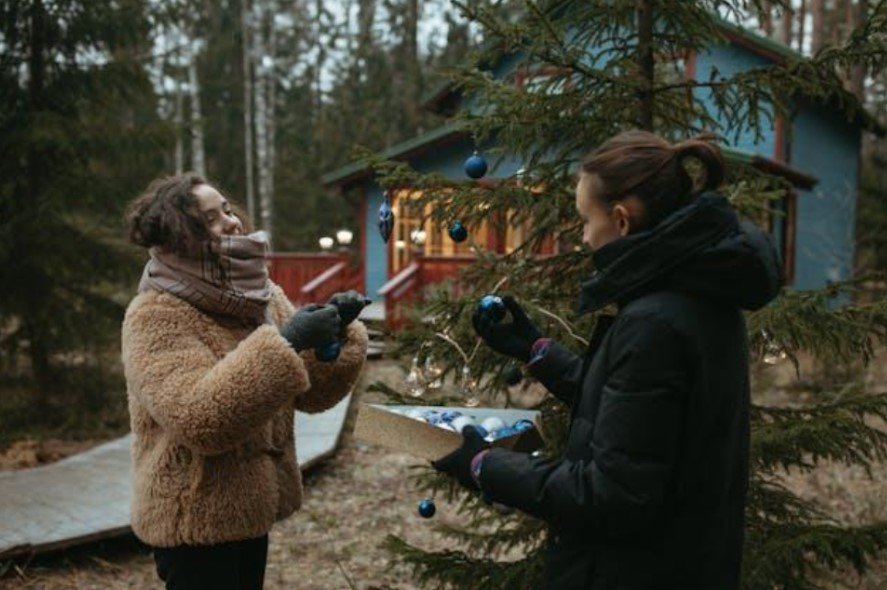Lifestyle
Staying Stylish & Warm at Outdoor Winter Events

Outdoor winter events test your resolve. You shiver in line at a holiday market, your toes numb during a football game, and you sacrifice style for bulk, hoping to avoid frostbite. Frigid winds slice through thin fabrics, damp snow soaks your shoes, and you juggle hot drinks, phones, and frozen fingers.
Hypothermia is a buzzkill—a dangerous one, at that. The chances of that happening escalate if you underestimate the cold while partying. Yet abandoning style feels like surrender, and for many of us, that just won’t do.
This guide solves both problems. Let’s go!
Fabric Technology Deep Dive
Before diving in, note that some fabrics perform better than others during extreme weather.
Explore phase-change materials (PCMs), used in high-performance base layers. These fabrics absorb excess heat when you’re active and release it when you’re still, balancing temperature dynamically.
For example, a runner wearing a PCM-infused shirt stays warm during rest periods at a winter marathon aid station but avoids overheating mid-race. Compare this to merino wool, which excels in odor resistance—ideal for multi-day ski trips where laundry access is limited.
Color also matters in layering. Darker base layers hide stains during messy outdoor feasts, while bright mid-layers (like a cobalt fleece) add pop under neutral coats. At a holiday market, pair a charcoal merino turtleneck with a crimson puffer jacket. You’ll stand out in photos while staying invisible to the cold.
Keep all these things in mind as you build the perfect layer for your outdoor winter adventures!
Master Layering Without Bulk
Staying warm during winter without looking like an overstuffed penguin is an art. Layering is the foundation for that. Master that and everything else becomes easy.
Base Layer: The Foundation of Warmth
Start with a thermal base layer. Wool or synthetic blends like polyester or nylon are good choices. These fabrics wick moisture away from your skin. That prevents sweat from cooling and chilling you. If you’ve dismissed wool as scratchy, test a merino blend against your neck for 10 minutes. The result? No redness, no irritation.
Avoid cotton entirely. Cotton absorbs moisture and clings to dampness, turning your base layer into a cold, soggy trap. Imagine skiing in cotton thermals: within minutes, sweat accumulates, and you shiver uncontrollably. Switch to Merino, and you stay dry even after three hours on the slopes.
You want a fit that’s snug. That means as tight as possible without restricting your movement. Snugness is what traps body heat efficiently. For example, a cyclist wearing a loose synthetic shirt under a jersey will experience cold air circulating inside their clothes. A fitted base layer eliminates gaps, sealing warmth close to the body—exactly what you need.
Mid-Layer: Strategic Insulation
Next, add an insulating mid-layer. Fleece, down, and synthetic puffers work best. Prioritize lightweight materials with high warmth-to-weight ratios.
A common misconception is that thick sweaters provide superior insulation. In reality, a thin down vest under a tailored wool coat traps heat more efficiently. Down’s loft creates air pockets that retain warmth without adding bulk. Test this by wearing a fleece jacket under a wool coat during a 20°F day. The fleece traps heat, while the wool blocks wind.
To stay extra toasty, you may want to look into battery-powered heated vests. Modern ones are slim, unobtrusive, and long-lasting. Lithium batteries power their discreet heating panels for up to 10 hours at a time. Pair one with a slim-fit parka, and you’ll avoid the marshmallow effect without sacrificing coziness.
Outer Layer: Weatherproof Armor
Finish off your outfit with a weatherproof shell. You want to be confident in both your overall look as well as your safety.
For regular winter events, Gore-Tex and similar waterproof, breathable fabrics repel snow and wind while letting sweat vapor escape. Sealed seams prevent leaks. This will also be useful for when you’re walking around to get from place to place, as in outdoor sports games or al fresco parties.
For formal events, the functional but sometimes garish look of Gore-Tex might not be appropriate. We’d look into trench coats lined with Thinsulate, a synthetic insulation thinner than down. This helps minimize the volume of your look, making it that much easier to stay sleek and warm at the same time.
For an outdoor winter wedding, for instance, a good look might be a wool-blend coat over a velvet holiday dress. The coat blocks wind, while the velvet’s dense weave adds subtle warmth and luxe texture.
Prioritize Core Warmth to Protect Extremities
1. Heated Core, Happy Extremities
Your core acts as your body’s furnace. Insulate it first to safeguard hands and feet. A heated vest provides steady warmth without bulk. Critics assume battery packs are clunky, but newer models can weigh around 8 ounces and fit in a jacket pocket. At a multi-hour event like a tree-lighting ceremony, activate the vest’s medium setting. Your core stays warm, directing blood flow to your fingers and toes.
2. Mittens vs. Gloves: The Heat Retention Battle
Mittens outperform gloves. Grouping fingers allows them to share warmth.
Leather mittens with plush linings, like cashmere, also offer dexterity and luxury. They also allow you to handle cash or smartphone screens with ease. Test this by tapping your phone with glove fingertips versus mittens. Glove fingertips require repeated swiping, while mittens let you use your entire hand for better accuracy.
3. Head and Neck: Critical Heat Zones
A cashmere beanie traps 20% more heat than acrylic knits. Wrap a silk scarf under your coat collar to block drafts. At a football game, an acrylic hat may itch by halftime. Switch to merino wool, and comfort lasts through overtime.
Scarves don’t cut it when you’re outdoors during winter. Swap them out for merino wool neck gaiters. Their tubular design blocks drafts better than traditional scarves. At an outdoor ice sculpture contest, for example. Just pull the gaiter over your nose during wind gusts. You won’t miss a single thing!
4. Waterproof Boots: Non-Negotiable
Rubber soles with deep treads prevent slips on ice. For more formal gatherings, pair shearling-lined ankle boots with wool socks and your favorite dress. Dance on icy pavement without freezing!
Thinsulate linings add warmth without expanding shoe size. Knee-high boots with a velvet dress elevate a holiday party look while navigating salted sidewalks. Avoid fashion sneakers—their thin soles and lack of insulation invite cold.
Always try to test boots before committing. Standing on a snowbank for five minutes should be enough. Quality boots with sealed seams keep feet dry.
Accessorize Strategically
Finish off your look with whatever works best:
Tech-Friendly Gloves
Upgrade to touchscreen-compatible leather gloves with capacitive fingertips. Text at a holiday light show without exposing skin. There are several brands out there that offer gloves with removable inner liners—swap them if sweat dampens the material during a snowshoe hike.
Heated Insoles
Discreet battery-powered insoles fit into dress boots, perfect for those rooftop New Year’s Eve parties that go all night. Set the low setting for consistent warmth while preserving battery life.
A Good Thermos
A stainless steel thermos with a leather sleeve keeps drinks hot for hours. Sip ginger tea during a winter hike to combat fatigue. Avoid plastic bottles—they crack in sub-zero temps.
Functional Bags
Choose a water-resistant nylon crossbody bag with anti-theft zippers. Roam a festival without snow damaging leather or freezing your hands. This is also where you can store backup batteries for your heated accessories.
Prepare for Emergencies
Not planning for the worst-case scenario during winter is a risk no one should take. Don’t let sudden cold snaps ruin your fun—all it takes is a few extra items you can tuck away so you can keep partying until the very last moment.
Some of the things we always bring along:
Backup Heat Sources
Adhesive body warmers revive circulation. Stick one to your lower back when the wind starts approaching frosty.
Waterproof Shoe Covers
Slip them over heels in slushy parking lots to stay away from nasty spills that could make you a well-dressed patient in the emergency room. Remove them indoors and stash them away for the trip back. Spotless soles, unbroken bones…what’s not to like?
Skin Protection
Apply a glycerin-based balm to exposed skin. At a windy outdoor photo shoot, this prevents windburn while avoiding the greasy feel of petroleum jelly.
Emergency Blanket
This is for the big ones. Store a compact, reflective blanket in your car. It reflects 90% of body heat if stranded.
Signal Strategies
Pack a whistle and LED clip light in your crossbody bag. If stranded during a snowstorm, attach the light to your coat for visibility. The whistle’s sound carries farther than voices in the wind. They’ll help you get the attention of passersby in case you need help.
Wrapping Up
Outdoor winter events demand creativity, not compromise.
Remember: every detail, from insoles to insulation, contributes to warmth and style. Test combinations at home—wear your full outfit while doing everyday activities like checking your email. Adjust layers, refine accessories, and make tweaks until you find the perfect balance of comfort and function.
-

 Social Media2 months ago
Social Media2 months agoWhat the “67” TikTok Meme Really Means
-

 Tech2 months ago
Tech2 months agoWhat To Do When Your Business Faces Network Vulnerabilities
-

 Self Improvement2 months ago
Self Improvement2 months agoUsing BCBS Rehab to Access Quality Addiction Care
-

 Games2 months ago
Games2 months agoPusoy Strategies for Play That Also Work in Pusoy Dos in English






